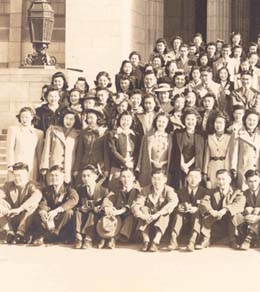On May 18, 2008, in Seattle, the University of Washington holds a graduation ceremony to honor 450 Japanese American (known as Nikkei) students who were forced to leave the UW for incarceration camps during World War II under President Franklin D. Roosevelt's (1882-1945) Executive Order 9066. Nearly 200 Nikkei students or their surviving family members attend and receive honorary diplomas after a 66-year wait. A crowd of 900 attends the ceremony at UW's Kane Hall.
Nikkei at the UW
At the time of Japan's attack on Pearl Harbor on December 7, 1941, there were an estimated 450 Nikkei students at UW. They were the largest minority on campus; only University of California at Berkeley had a higher percentage of Nikkei students enrolled.
Since University of Washington fraternities and sororities banned all Asians and other ethnic minorities, the Japanese Student Club served as a social center for the Nikkei student community. The day after Japan’s attack on Pearl Harbor, some students expected hostility from their peers at UW.
However, despite war hysteria, suspicion, and racism throughout the nation, the reaction on campus was relatively mild. The school’s student newspaper, The Daily, published a number of editorials from December 8, 1941, until the government forced the Nikkei students to leave, which argued against intolerance and mob mentality. And, less than a week after the attack on Pearl Harbor, Assistant Dean Robert O’Brien, a sociology professor at UW, began helping Nikkei students get copies of their birth certificates in order to prove their American citizenship.
Though curfews and other ordinances quickly fell upon Japanese Americans, no one guessed in late 1941 that the government would inter American citizens. UW President Lee Paul Sieg appointed O’Brien as his aide on the student relocation issue, as the dean was the adviser to the Japanese Student club. O’Brien attempted to place Nikkei students at other colleges outside of the West Coast, both at the undergraduate and graduate level.
Executive Order 9066
On February 19, 1942, Roosevelt signed Executive Order 9066, which gave the military the right to create areas where it could impose restrictions on Japanese Americans as it saw fit. Days later the Tolan Committee of the U.S. House of Representatives began hearings about “evacuations.” Japanese Americans found their hands tied, as any dissent or protest over the “relocations” would mean being labeled unpatriotic or unAmerican. Roosevelt’s order would lead to the incarceration of nearly 120,000 Japanese Americans, more than half of them American citizens.
Shortly after General John L. DeWitt (1880-1962) banned all Japanese Americans from the West Coast on March 1, 1942, Seig wrote a letter to 25 college presidents, pleading with them to accept the university’s Nikkei students, but he also agreed to comply with any orders that UW received from the army. In the middle of March, O’Brien met with military authorities in San Francisco to discuss a possible exemption of UW students from the incarceration order at least until the end of the spring quarter in June. O’Brien had little luck at the conference; the military promised only to pay for the transportation costs of Nikkei students transferred to other schools.
Most schools, though, were unwilling to accept students of Japanese ancestry. Many that did help Nikkei students withdrew their offers after the Associated Press subjected them to public ridicule by printing a list of 14 schools accepting the transfers.
The army finally announced Civilian Exclusion Order No. 57 on May 10, 1942, ordering all Japanese persons, whether or not they were American citizens, to leave Seattle by noon on May 16. The UW students and other Japanese Americans from the Seattle area were taken to an assembly center at the Puyallup Fairgrounds called “Camp Harmony.” Sometime in late June, an unnamed dean, who is now believed to have been Business and Economics Dean Howard Preston, perhaps along with a couple of other UW officials, held an informal graduation ceremony for the Nikkei students who had been only one month from finishing their college educations. There is no official record of the commencement ceremony, because the decision would have been very unpopular at the height of war hysteria. Not long after the ceremony, the army moved the group to the Minidoka incarceration camp in Idaho.
Making Amends
Though some of the students received their undergraduate degrees from UW, most of the 450 Nikkei students did not. Nearly three-quarters of the students went on to later earn college degrees from other institutions, but their time at UW was not recognized until May 2008. After researching the experiences of UW’s Japanese American students with Theresa Mudrock and members of the UW library staff, Tetsuden Kashima, a professor of American ethnic studies at UW, petitioned the UW Board of Regents to award the honorary degrees.
In February 2008, the regents voted to issue 450 honorary degrees to the Nikkeii students. Before these degrees, the Board of Regents had awarded only 11 honorary degrees since 1885. The May ceremony served both as a both a reminder of the injustices suffered by Japanese Americans in World War II and a celebration of their lives.

